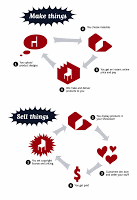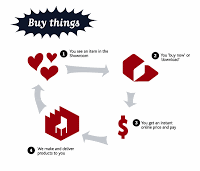 One of the most interesting companies in today’s fabrication space is Ponoko, a New Zealand based start-up that seems to be a mashup of a 3D print service, eBay and design library. We thought we’d better take a deeper look at them, and we interviewed Steven Kempton, Ponoko’s Blog Editor.
One of the most interesting companies in today’s fabrication space is Ponoko, a New Zealand based start-up that seems to be a mashup of a 3D print service, eBay and design library. We thought we’d better take a deeper look at them, and we interviewed Steven Kempton, Ponoko’s Blog Editor.
Fabbaloo: Tell us the story of how Ponoko came into being?
- Dave, a web software guy who is used to clicking his mouse to ‘make’ software products and get instant feedback while doing so, started making real things. He was a master of his digital world and wanted to extend this into the real world – aka, bits to atoms. In doing so he ran into one of the most antiquated processes he could have imagined – making real things was really really hard! He thought there must be an easier way..
- Derek and Dave were working on a project to help solve the climate change problem – and it became clear that one of the ways to cut carbon emissions was to produce goods only when they are needed and as close to the point of consumption as possible. On-demand manufacture means less wasted goods in the world and making as close to the consumer as possible means less shipping and storage of goods.
In 2006 they agreed to pursue a way to change the world – give everyone the ability to make the products of their dreams with the click of a mouse and enable people to make a living from creating and making them.
Fabbaloo: What kind of person uses Ponoko? Hobbyists? Small businesses? Large businesses?
Currently 2 types:
Creators – hobbyist, amateur and professional industrial / product and graphic designers, product and software engineers, crafters, makers, hackers and artists.
Consumers – anyone interested in buying original and individualized goods and/or the product plans to make them.
Fabbaloo: What do they find attractive about the Ponoko concept that makes them come back?
Steven Kempton: In a phrase = cost effective simplicity.
We’re the easiest and most profitable way for designers to make and sell their product ideas – and we’re the easiest and most cost effective way for consumers to buy original products.
2 things for creators:
- Your personal factory – they can click to turn their ideas into real products. We have massively simplified the making process – when you compare all the things you need to do to get something made before and after Ponoko, the differences are astounding and you’re left wondering how anyone has endured today’s traditional making process.
- Your online showroom – they can turn their creativity into cash. We are the first in the world to enable someone to both make and sell in one place.
2 things for consumers:
- Search – they cut their time in the search for original goods direct from designers, which is traditionally a random drawn out process best suited for people who are time rich.
- Buy – they cut the cost to buy original goods direct from designers, which is using reserved for people who are cash rich.
Fabbaloo: Does Ponoko plan on expanding in the future? What form would that take?
Steven Kempton: We’re expanding all of the time in many ways, while always keeping top of mind that we want to be fantastic at what we do – meaning we do not expand for the sake of it. The key area that is most important to both our creators and consumers is enabling a larger variety of quality goods to be made. This means expanding both the materials catalog and the manufacturing techniques. And then there’s expansion of all of the online tools we need to supply to keep making it easier and easier to share, sell, buy and make products and product plans.
Fabbaloo: How successful has Ponoko been over its brief lifetime?
Steven Kempton: Very 😉 … But like all start ups we’re impatient and want to see us rolling out more cool stuff as soon as we are able to enable people to release their creativity to the world, not just in the digital world but in the real world too.
Fabbaloo: What new manufacturing equipment do you intend on adding in the near future?
Steven Kempton: It ranges from metal laser cutting, to 3D printing, to CNC routing. And beyond.
Fabbaloo: Currently you have two manufacturing nodes, Wellington and San Francisco.. When and where will the next nodes appear?
Steven Kempton: All depends upon the areas of most demand. It’s likely to be the East coast next.
Fabbaloo: What do you see as Ponoko’s biggest challenges in the next few years?
Steven Kempton: The typical growing pains of a start up. Biggest challenge is not enough hours in a day.
Fabbaloo: How do you feel about the coming rise of personal desktop manufacturing? How will Ponoko adapt when most people can print out parts on their own desktops?
Steven Kempton: Ponoko is the world’s largest marketplace for product plans. Creators and consumers use these plans to share, buy, sell and make individualized goods.
So we see ourselves ideally positioned for this because we’re the source of the printable product plans – and the place where people share them, co-create, exchange ideas, knowledge, etc.
Fabbaloo: Ok, we have to ask this final question: what is the correct way to pronounce “Ponoko”?
Steven Kempton: However it comes out 😉 … Bruce Sterling described it the best as “po-NO-ko, with a New Zealand accent”
Good luck, Ponoko! Or should we say poNOko?
Via Ponoko.com


 Creators – hobbyist, amateur and professional industrial / product and graphic designers, product and software engineers, crafters, makers, hackers and artists.
Creators – hobbyist, amateur and professional industrial / product and graphic designers, product and software engineers, crafters, makers, hackers and artists. Consumers – anyone interested in buying original and individualized goods and/or the product plans to make them.
Consumers – anyone interested in buying original and individualized goods and/or the product plans to make them.
This company sounds like a great idea! I wonder who exactly does the actual making of the product? Are they just employees of Ponoko in a big factory somewhere?